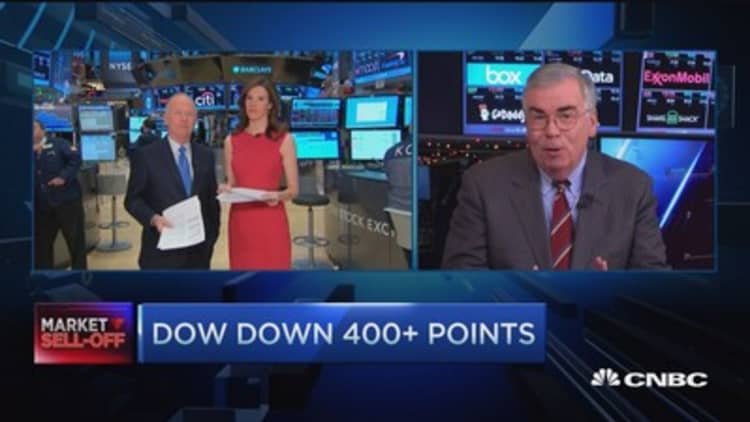

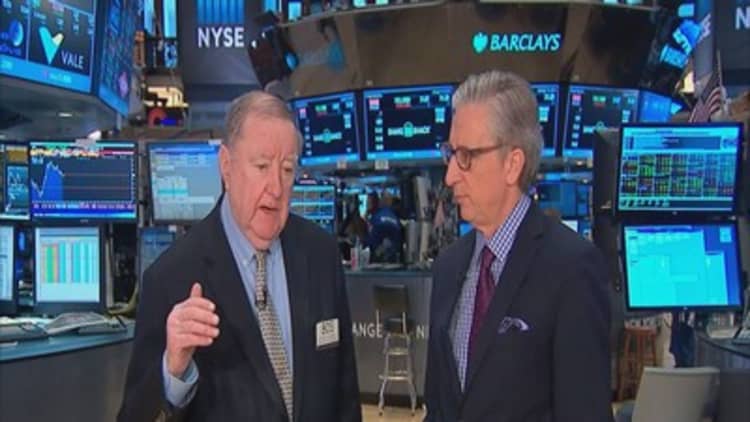
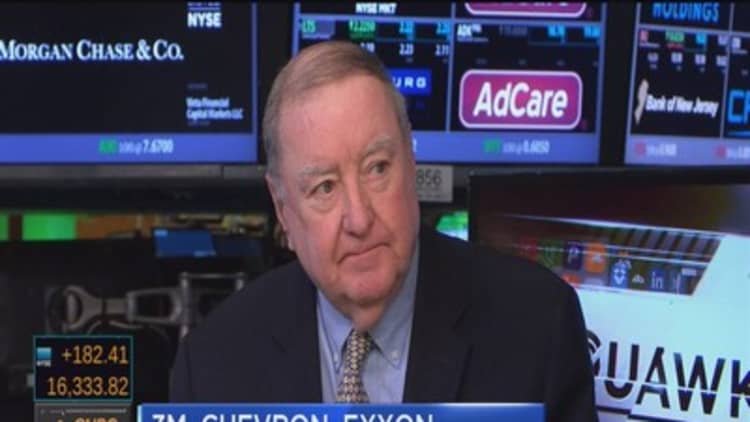

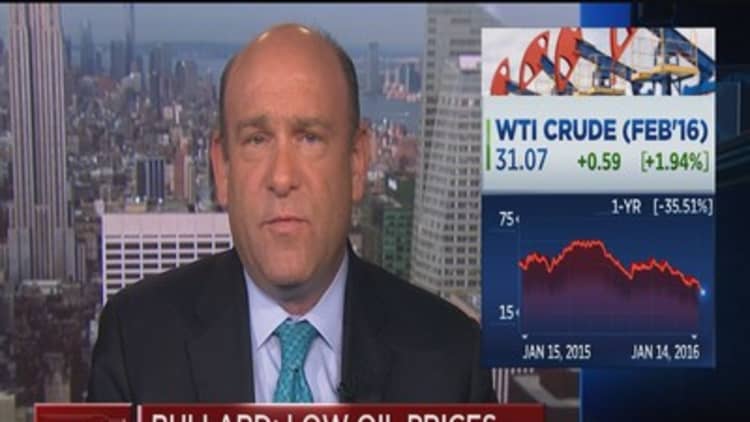

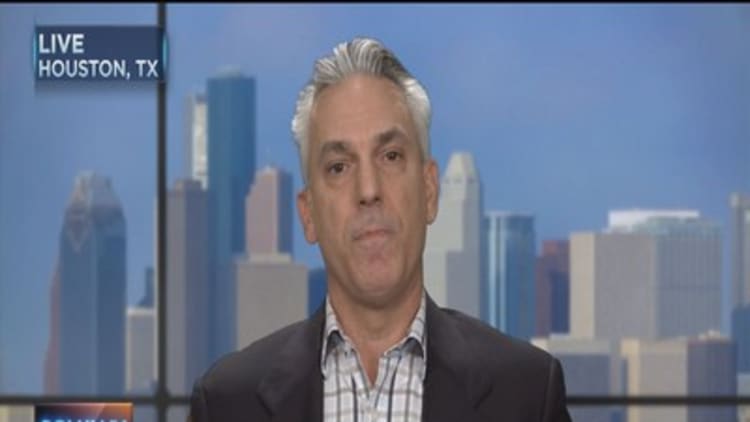
U.S. stocks closed higher Thursday, stabilizing after a steep sell-off, helped by some recovery in oil prices and comments from Fed policymakers that indicated possibility of an even more gradual pace of tightening. (Tweet This)
The major averages ended off session highs, but up more than 1 percent for the day for their best day since Dec. 4. The S&P 500 was on track to end the week unchanged but down nearly 6 percent for the year so far.
The Dow Jones industrial average closed about 225 points higher. The index briefly gained 330 points in afternoon trade, with Chevron and Exxon Mobil contributing the most to gains.
Read MoreRebound: Stats say Dow correction is over for now
Also supporting gains was a 1.5 rise in shares of JPMorgan Chase after the banking giant reported net income of $5.4 billion, earnings per share of $1.32, on revenue of $23.7 billion, beating estimates.
"You got good news out of JPMorgan that set the tone for the day and reminds investors it's not the end of the world," said Jack Ablin, chief investment officer at BMO Private Bank. He noted valuations are still on the high end.
The Nasdaq composite closed up 1.97 percent after earlier rising 2.5 percent but still more than recovering from a 1 percent intraday dip.
The S&P 500 closed up 1.67 percent, back above the psychologically key level of 1,900 as energy closed up nearly 4.5 percent to lead all sectors higher. Energy had its best day since Aug. 27, but is still more than 20 percent lower for the last 12 months.
U.S. crude oil futures settled at $31.20 a barrel, up 72 cents, or 2.36 percent.
Read More How to tell a bull correction from a bear market
There's an "ongoing bid in energy. That helps," said Art Hogan, chief market strategist at Wunderlich Securities. He also attributed support for gains to extremely oversold conditions and more accommodative remarks from Federal Reserve policymakers.
St. Louis Federal Reserve President James Bullard said Thursday that a continued decline in inflation expectations may change his outlook for further Fed rate hikes. Bullard is a voting member of the central bank's policymaking committee.
The Fed's Bullard also said in his speech Thursday morning that the recent move in oil prices has been "very substantial" and has implications for monetary policy, although low oil prices are a "net positive" for the U.S. economy.
The comments followed remarks Wednesday from another voting member, Boston Fed President Eric Rosengren, that global and U.S. economic growth may be slipping and force a more gradual pace of tightening than officials currently expect.
"That's working its way into the marketplace today. ... Bullard's commentary is very constructive for the market," Hogan said.
Treasury yields held lower, with the near 0.91 percent and the 10-year yield at 2.09 percent. The curve, which flattened in recent sessions, steepened, not surprising given the stock rally.
The Treasury auctioned $13 billion in 30-year bonds at a high yield of 2.905 percent.
"It's probably a contributing factor," said John Briggs, head of strategy at RBS. "If you wanted to, you could argue the front end is moving on Bullard, but slightly."
New York Fed President William Dudley, known to be dovish, is scheduled to speak Friday.
Read More March could be off the table for Fed rate hike
The U.S. dollar index held slightly higher.
The major U.S. stock indexes rallied in mid-morning trade after initially struggling to hold slight opening gains. Analysts attributed much of the advances in stocks to short-covering on firming oil prices amid talk of a moderate to hawkish Fed voting member tilting dovish.
"I think that an element of this is short covering and besides energy, some of the comments out of Fed speakers, especially Bullard, are saying (inflation could be pressured by low oil)," said Peter Cardillo, chief market economist at First Standard Financial.
Oil held higher but still near multi-year lows, with both U.S. crude and Brent above $31 a barrel. Brent settled up 2.38 percent at $31.03, its second-straight settle below WTI.
"There's a pretty good case that one can make that energy is putting in a temporary bottom," said James Meyer, chief investment officer at Tower Bridge Advisors, noting stocks could be "setting up for a tradable rally."
Read MoreOuch! Here's where stocks could go next
"There could be some bounces here but the markets are resetting to lower growth in 2016 and 2017 and how much lower growth that is, is still to be determined," said Nick Raich, CEO of The Earnings Scout.
"We're not measuring anything in this data that suggests growth is going to fall off the cliff," he said.
In economic news, weekly jobless claims rose to 284,000.
December import prices fell 1.2 percent, for a sixth-straight month of declines as the cost of petroleum and a range of other goods fell further, suggesting a tame inflation environment could persist in the near term, Reuters said.
Read More$3.17 TRILLION wiped off global stocks so far this year
The major U.S. averages lost more than 2 percent Wednesday and closed more than 10 percent below their 52-week intraday highs, in correction territory. On Wednesday, the S&P 500 closed below 1,900 for the first time since September.
The Dow and Nasdaq composite remained in correction territory in the close Thursday. The S&P 500's gains brought the index to within 10 percent of its 52-week intraday high, out of correction.
"We just won't know for some weeks whether that was the bottom or not," said Dan Veru, chief investment officer at Palisade Capital Management.
"I'm encouraged the prior bottoms have held," he said. "The S&P opened higher, traded up there to 1,898, then traded down to 1,878, near 1,875-1,870 (around the September lows). Prior bottoms just continued to hold."
The U.S. dollar reversed an earlier decline to hold about 0.2 percent higher against major world currencies, with the euro near $1.086 and the yen at 118.09 yen against the greenback.
Overnight, the People's Bank of China set Thursday's yuan mid-point rate at 6.5616, compared with Wednesday's fix of 6.5630.
European stocks closed more than 1.5 percent lower Thursday. Asian stocks ended mostly lower, with only the Shanghai composite closing higher, up nearly 2 percent.
Minutes from the European Central Bank's Dec. 3 meeting showed euro zone inflation could miss the bank's already lowered forecast, but the ECB needed to keep some power dry in case conditions require further policy easing, Reuters said.
Risks, particularly from emerging markets and geopolitical turmoil, continue to weigh on euro zone growth while governments are still not doing their part in fostering growth with reforms and fiscal accommodation, the report said.
In other central bank news, the Bank of England held rates at a record low of 0.5 percent, in-line with expectations.
Major U.S. Indexes
The Dow Jones industrial average closed up 227.64 points, or 1.41 percent, at 16,379.05, with Chevron leading advancers and Home Depot and Nike the only laggards.
The Dow transports closed up more than 1 percent, still more than 20 percent below its 52-week intraday high.
The Russell 2000 remained more than 20 percent from its 52-week intraday high.
The closed up 31.55 points, or 1.67 percent, at 1,921.83, with energy leading all 10 sectors higher.
The Nasdaq composite closed up 88.94 points, or 1.97 percent, at 4,615.00. Apple closed up 2.19 percent. The iShares Nasdaq Biotechnology ETF (IBB) gained 4 percent for its best day since mid-October.
The CBOE Volatility Index (VIX), widely considered the best gauge of fear in the market, traded near 24.
About two stocks advanced for every decliner on the New York Stock Exchange, with an exchange volume of nearly 1.3 billion and a composite volume of 5.2 billion in the close.
Gold futures for February delivery settled down $13.50 at $1,073.60 an ounce.
Read MoreEarly movers: JPM, FCAU, BBY, GPRO, BA, GS, PFE & more
— CNBC's Patti Domm and Reuters contributed to this report.
On tap this week:
Thursday
Earnings: Intel, First Republic Bank, Shaw Comm.
Friday
Earnings: BlackRock, Citigroup, US Bancorp, Wells Fargo, PNC Financial Services, Fastenal
8:30 a.m.: Retail sales, PPI, Empire state manufacturing survey
9 a.m.: New York Fed President William Dudley
9:15 a.m.: Industrial production
10 a.m.: Consumer sentiment, business inventories
1 p.m.: Dallas Fed President Robert Kaplan
1 p.m.: Oil rig count
*Planner subject to change.
More From CNBC.com:






